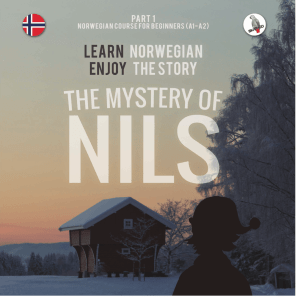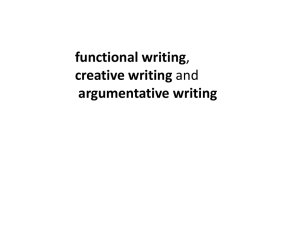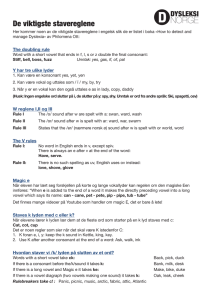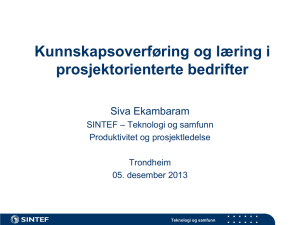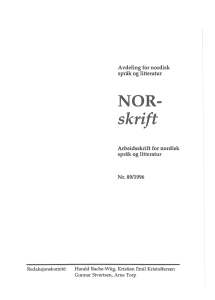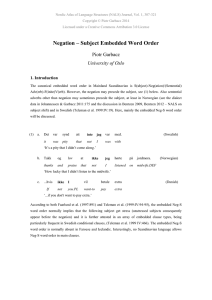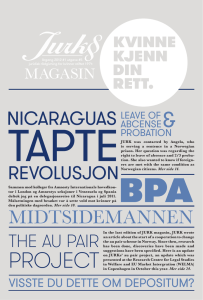Terminology - BroAschehoug
advertisement
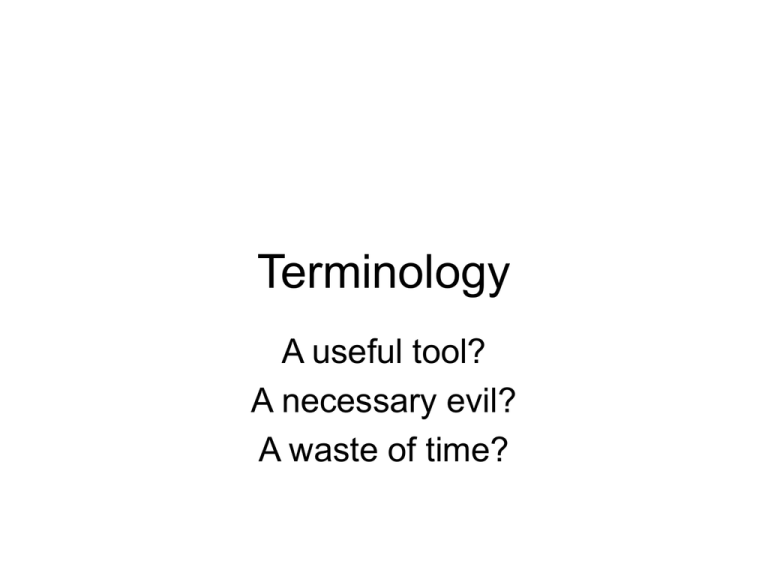
Terminology A useful tool? A necessary evil? A waste of time? What do curriculum objectives presuppose? • And what about the exam? Vg 1 discuss similarities and differences between English and other foreign languages • Word classes • Gender • Tenses • Case endings? Inflection? Conjugation? • Word order • Other points? Vg1 use relevant and precise terminology to describe the forms and structures of English • Word classes • tenses • Simple/progressive • Singular/plural • Sentence analysis? • Word order - Inversion? use a wide selection of digital and other aids independently, including monolingual dictionaries • Word classes • Infinitive • Countable/uncountable nouns • Formal/informal, slang, taboo, archaic • Other points? write formal and informal texts with good structure and coherence • Formal/informal, slang, taboo, • Sentences, clauses, paragraphs • Topic sentence • Other points? • explain the main characteristics of the development of English from an Anglo-Saxon language to an international world language • Loanwords • Germanic, Romance • From synthetic to analytic?? • From endings to word order • Other points? OR Does it just mean • “How did English get where it is?” Vg 2 • gjøre rede for grunnleggende trekk ved engelsk språkbruk og språkstruktur Vg 2 • gjøre rede for grunnleggende prinsipper for oppbygning av tekster i ulike sjangrer • Norsk 10. kl: …lese og skrive tekster i ulike sjangere, både skjønnlitterære og sakspregede på bokmål og nynorsk: artikkel, diskusjonsinnlegg, formelt brev, novelle, fortelling, dikt, dramatekst og kåseri • analysere språklige virkemidler i ulike typer tekster • Fra Norsk Vg1: ” … gjøre rede for et bredt register av språklige virkemidler og forklare hvilken funksjon de har” Vg 3 Samfunnsfaglig • drøfte sammenhengen mellom form, innhold og stilnivå i setninger i samfunnsfaglige tekster • analysere språklige virkemidler i tekster i ulike sjangrer og vurdere virkningen av dem Vg 3 Litteratur og kultur • drøfte sammenhengen mellom form, innhold og stilnivå i setninger og tekster • beherske terminologi til å analysere skjønnlitteratur, film og andre estetiske uttrykksformer • drøfte språklig særpreg ved tekster i ulike sjangrer fra ulike perioder og regioner Men hva med eksamen? • Hva trenger man der? • Vg1 • Våren 08 skulle de identifisere et avsnitt som var skrevet i et mer uformelt språk enn de andre, og påpeke de formelle aspektene. Våren 08 Sensorveiledning • I avsnitt tre finner vi: • 1) flere sammentrukne former: don’t, you’d og it’s • 2) de uformelle kortformene ok og info • 3) direkte tiltaleformer (vokativer) Kids,… og Mom and Dad • 4) don’t you give…,er nærmest er truende Og videre • 5) det strenge påbudet i formen you’d better teach • 6) formen your dear ones, som åpner for en sarkastisk tolkning • 7) formen every Tom, Dick and Harry, som har en negativ konnotasjon tilsvarende det norske ’Gud og hvermann’ • 8) et retorisk spørsmål Who knows what that might lead to? • De fleste bør klare å vise til de sammentrukne former (1) og uformelle kortformer (2); begge trekk er typiske for uformelt språkbruk. De som klarer å påpeke og beskrive effekten av en eller flere av formene i 3-8, og dertil bruke riktig terminologi, viser høy kompetanse. • Det er rom for å vise kompetanse på ulike nivåer her, men siden instruksjonen ber om ”three different ways”, er det ikke tilstrekkelig hvis man bare oppgir tre sammentrekninger (”don’t, you’d og it’s” ) . Eksamen Vg1 Våren 09 • Elevene skulle ordne rekkefølgen i noen avsnitt og begrunne 3 av sine valg. • I tillegg skulle de peke på noen formuleringer som viste forfatterens negative holdning. Våren 2009 Sensor veiledning The relative placement of a, c and g depends on the immediately preceding textual material. • A functions as a response to an explicit question, here a rhetorical question. That is why it must follow g. • C is introduced by consequently, another textstructuring element (a conjunct). By using it, the writer tells the reader that the statement in one sentence is a result/consequence of the meaning of the preceding sentence. This cause – effect sequence is marked explicitly when c follows h. • G is introduced by such ‘stars’. The use of such (‘stars’) - with inverted commas around ‘stars’ to mark ironic distance – tells us that they have been mentioned before. This is a strong reason why g should follow b. • The author’s attitude to celebrities is clearly negative. We see this in his/her choice of words such as empty-headed, ‘stars’, superficial, mere sheen, (people) with no talent, wisdom or education, outward beauty, unlimited selfconfidence. • But we can also see it in the negative statements which indirectly refer to the celebrities, e.g. true personal values do not count any longer, the rhetorical question: do they possess the true values of the past…?, and the clear conclusion: what is needed is a reorientation… International English Spring 2009 • 1 You didn’t see him, is it? • 2 When you would like to go? • 3 That man he is tall. • 4 Her jewelleries were stolen. • 5 I am understanding it now. • 6 They two very good friends. • 7 Sushila is extremely a lazy girl. • 8 When you leaving? Examiner guidelines • Følgende er forslag til forklaringer. De ordene som er uthevet, hører til grammatisk terminologi. Sensorene bør være åpne for andre, mindre detaljerte svar, og for at svar uten fagterminologi også kan være innsiktsfulle. • 1 You didn’t see him, is it? • Standard written English requires the question tag to consist of a pronoun that matches the first subject (here you), an auxiliary in the correct tense (here did), and a reversal of the polarity (positive versus negative) in the first statement (here from negative didn’t to positive did). • When you would like to go? • In standard written English the auxiliary (would) comes before the subject (you) in interrogative sentences. This is called inverted word order. • That man he is tall. • Even though the original form is not unusual in speech, in standard written English a 'double' subject like that man he is not used. • Her jewelleries were stolen • ) Jewellery is an uncountable noun in standard English, so the plural form cannot be used. When the subject is changed into the singular (jewellery), the verb (was) must agree with the subject • I am understanding it now • The present continuous/progressive form is not normally used with verbs that denote mental states. Understand is such a verb. • They two very good friends • The non-standard sentence has no verb. An appropriate verb has to be put it, in this case are • Sushila is extremely a lazy girl. • The adverb (extremely) modifies the adjective (lazy) and has to be placed in front of it, giving an extremely lazy girl. From “Int. Focus” • Figurative language: exaggeration, understatement, metaphor, simile, personification Vg 3 Lit/kul a) Write a text in which you answer the following question: What is the genre of Never Let Me Go in "Vedlegg 1", and what is the genre of "What is mobbing?" in "Vedlegg 2"? Give reasons for your answer. b) The writers use language in different ways in the two extracts. • Discuss some of these differences in language use in the two extracts. Illustrate the differences with specific examples from both texts. Examiner guidelines • fiction/non-fiction • Characters/setting/theme/plot • Narrative: beginning, a building up of tension, a climax and a resolution • 1st person narrator (”I”), normal chronology. • explanatory text : information, but it is ”depersonalised” Examiner guidelines • • • • • • • Germanic and Romance vocabulary Formal/informal Phrasal verbs Personal pronouns Sentence length Lexical density (adj/adv/noun/verb) Fiction/non-fiction • Heavy premodifiers • Grammatical complexity Task 3 3c) Write an analysis of the poem below pointing out its typical Romantic features. Samfunnsfaglig exam • d) • Select two metaphorical expressions from the first paragraph and explain their meanings by paraphrasing them. Exam Compare versions i) and ii) below. What is lost in version ii)? i) I would advise you to remember that you did not create the disaster that the world is experiencing, and you alone are not responsible for bringing the world back to balance. A primary responsibility that you do have, however, is to cultivate happiness in your own life. ii)I would advise you to remember that you did not create the disaster that the world is experiencing, and you alone are not responsible for bringing the world back to balance. You have a primary responsibility to cultivate happiness in your own life. Guidelines • Three different features of the first version emphasise the contrast between what Obama is responsible for and what he is not responsible for: • - the fronting of "A primary responsibility that you …" • - the emphatic use of "do" • - the explicit contrast expressed in "however" • These features are lost in version ii).
